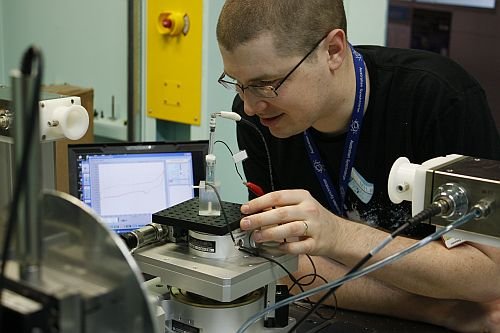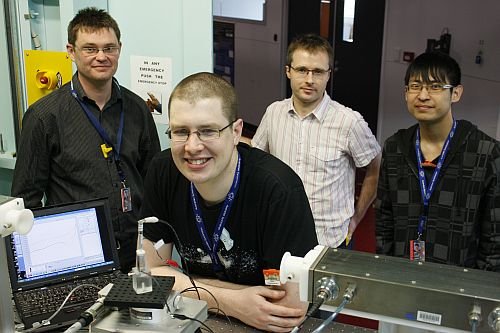Gold nanoparticles could hold the key to the development of highly-efficient fuel cells that convert alcohol into energy.
Glycerol is a kind of alcohol with some very attractive properties as a potential energy source. It’s renewable, non-toxic and energy-dense, and much safer to use than hydrogen or fossil fuels.
Scientists have demonstrated that it’s possible to oxidise (burn) glycerol in a fuel cell to produce energy. The problem is that so far, the process is just too slow.
 Dr Aaron Marshall and his team from the University of Canterbury, New Zealand, have taken on the challenge. They’re developing a way to make the process “superfast”, using electrocatalytic gold nanoparticles, which have a very high surface area. Their nanoparticles vary in size from just nine gold atoms (clusters) to around 100 and in some cases even thousands of atoms.
Dr Aaron Marshall and his team from the University of Canterbury, New Zealand, have taken on the challenge. They’re developing a way to make the process “superfast”, using electrocatalytic gold nanoparticles, which have a very high surface area. Their nanoparticles vary in size from just nine gold atoms (clusters) to around 100 and in some cases even thousands of atoms.
The activity of the gold nanoparticles depends on their size, with higher surface-to-volume ratio in smaller nanoparticles generally linked to higher performance – except that this principle doesn’t appear to work for very small clusters. This phenomenon could well be due to the distorted atomic structure in the nanoparticles compared to the bulk metal.
Photo at right: Jared Steven, PhD student, University of Canterbury, setting up an experiment at the Australian Synchrotron
In August 2013, Aaron visited the Australian Synchrotron with his colleagues Jared Steven and Calvin Lim to study the formation and electrochemical properties of gold nanoparticles at the x-ray absorption spectroscopy (XAS) beamline. The XAS beamline’s second experimental hutch is ideally suited to such work, being specifically designed to accommodate equipment brought onsite by users such as specialised in-situ sample stages.
The researchers used in-situ electrochemical XAS to investigate how the underlying catalytic behaviour of the nanoparticles is affected by nanoparticle structure and size distribution, ligand coverage (the ligands are used to control particle size during nanoparticle synthesis), and the presence or absence of a gold oxide monolayer on the nanoparticles. XAS techniques are ideal for studying particles smaller than five nanometres across, especially their structure and any surface changes prompted by the electrolyte environment. The team also looked at how the structure of the gold nanoparticles changes over time and with varying the electrode potential to mimic the conditions found in an operational fuel cell.
Preliminary findings show that gold nanoparticles containing approximately 100 atoms per particle tend to grow as the electrode potential is cycled between oxidising and reducing conditions. While the exact mechanism of growth has not yet been established, the researchers believe the phase transformation from metallic to oxidised gold drives this growth process. This is important, and most literature suggests that gold nanoparticleS are most active for the alcohol oxidation reactions within fuel cells when the particles are partially oxidised. The formation of the gold oxide monolayer on the nanoparticles was easily observed during the course of the in-situ XAS measurements as the electrode potential was varied.
Particles larger than about 3 nanometres in diameter did not undergo significant growth. This suggests that fuel cell electrocatalysts based on gold need to be either larger than 3 nm or stabilised on an appropriate support material. Overall, the use of in-situ electrochemical XAS is enabling the researchers to better understand how the properties of these catalytic materials vary under operating conditions so that better and more stable catalysts can be developed.

Photo above (L-R): Aaron Marshall (UC), Jared Steven (UC), Bernt Johannessen (AS) and Calvin Lim (UC) in the XAS beamline hutch at the Australian Synchrotron
Aaron's collaborator Dr Vladimir Golovko and PhD student Diandree Padayachee did not visit the Synchrotron on this occasion, but have been involved in previous beamtime trips.
